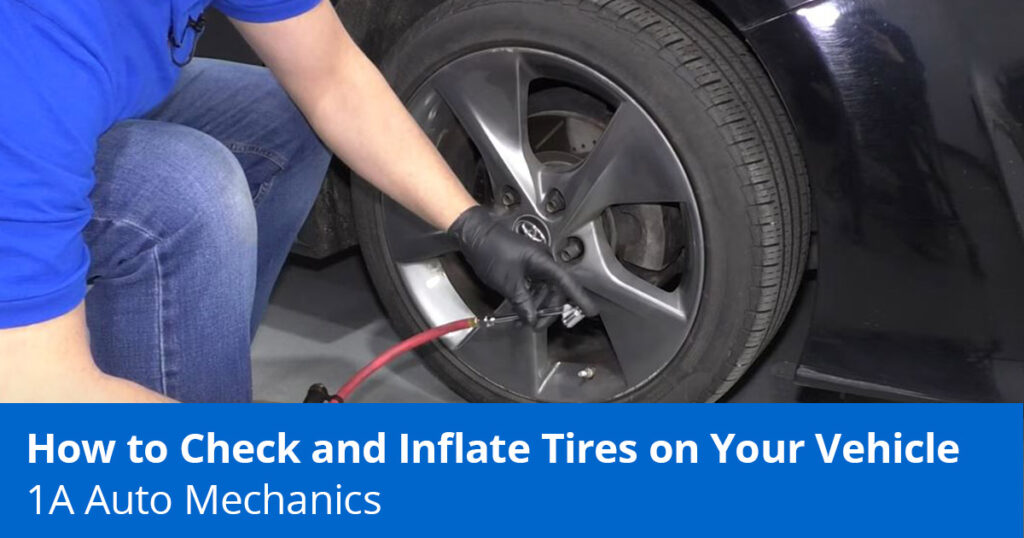
Many drivers don’t check their tire pressure but it’s important to do. This is especially true if you drive often, like owning a rideshare car or driving one for work. Checking the tire pressure can also keep you safe, save you money, and is part of routine car maintenance. This post and video reviews how to check the tire for air, how to put air in a tire, why tires need to be maintained and what can happen if they aren’t, and what to do if the tire pressure indicator light is still on after the tires have been filled.
Shop Quality Auto Parts at 1aauto.com

How to Maintain and Put Air in Your Vehicle’s Tires
What Can Happen with Overinflated or Underinflated Tires?
- Worse handling
- Worse fuel economy
- Wears and damages the tires faster
1. Worse Handling
Overinflated or underinflated tires can compromise your car’s handling. They can pull you off the road at regular street and highway speeds and possibly cause an accident.
2. Worse Fuel Economy
Low tire pressure can also negatively affect the fuel economy. The engine and transmission will have to work harder, causing a drag on the vehicle and a drop in fuel mileage.
3. Tires Wear Faster and Damage Easier
Tires with too much or too little air can also wear out faster and damage easier. They’ll be less resistant to the road and its debris and cost you more money in the long run.
How to Inspect the Tires Before Driving

It’s a good idea to check the tires every day before driving. See if the tires look flat. Although tires can look over inflated or under inflated, checking them every day will give you an idea of when a tire looks low.
Read more about how to check the condition of your tires
How to Put Air in the Tires
Steps for how to put air in a tire
- Find the Manufacturer’s Recommended psi
The air pressure is measured in pounds per square inch (psi), and how much air to pump into the front and rear tires will be listed on a sticker on the door or in the door jamb.

The tire may have the max pressure listed on the side of it. This measurement is not the amount of air the tire needs, but is the maximum amount of air pressure the tire can handle. - Check the psi with a Tire Pressure Gauge
It’s a good idea to have a tire pressure gauge in your vehicle to check the tire’s air pressure when needed. Make sure the tires are cool before checking how much air is in them. For example, you don’t want to check the tires right after driving on the highway. If you check a tire’s air pressure when the tire is warm, the measurement will read higher than accurate.
Remove the cap from the valve stem. Press and seal the tire gauge onto the valve stem. The gauge will take a reading of the tire’s air pressure. If the tire has too much air, there may be a button on the tire gauge that allows you to press the center of the valve stem and let air out. It does not take much to let air out and you can drop the air pressure by 2-3 psi in 2-3 seconds.
- Inflate the Tire to the Correct psi
The procedure for inflating the tires is similar to the one for checking them. Press and seal the tire inflator onto the valve stem tightly so you can’t hear air leaking. Pull the handle and inflate the tire.

- Check the Tire’s Pressure with a Gauge to Confirm It Met the psi
Once you have inflated the tire with more air, remove the inflator and check the tire’s psi with a tire pressure gauge. Stop inflating the tire once it measures for the correct psi.
Replace the valve stem cap to keep dust and dirt out of the valve stem.
What to Do If the Tire Pressure or ABS Sensor Light Is Still on After Filling the Tires
Some vehicles have tire pressure monitors. Some of these monitors are sensors in the tire, and sometimes the ABS system monitors the tire pressure. They can appear on the dash when a specific tire has low air, and some will just warn the driver that an unidentified tire has low air.
If the tire pressure light or ABS sensor light turns on after the tires have been filled, the light may need to be reset, or the tire pressure monitors may be defective. Tire pressure monitors have batteries that can die and usually last for around 8 years.
Learn How to Work on Your Own Car
Learn how to do your own repairs with 1A Auto’s how-to videos that have step-by-step instructions from professional mechanics. The 1A Auto video library has thousands of videos specific to many makes and models.
Related Content
- How to Check Tire Tread for Wear
- Tire Size Guide—What the Letters and Numbers Mean
- Slow Leak in Tire? How to Find and Fix Tire Leaks
- Low Tire Pressure in Cold Weather
- Car Pulls to the Right or Left?
- How to Tuneup a Car: Car Tuneup Checklist
- How to Remove a Stuck Tire
- DIY Alignment
- How to Remove a Stripped Lug Nut from a Tire
Shop Parts and Tools


